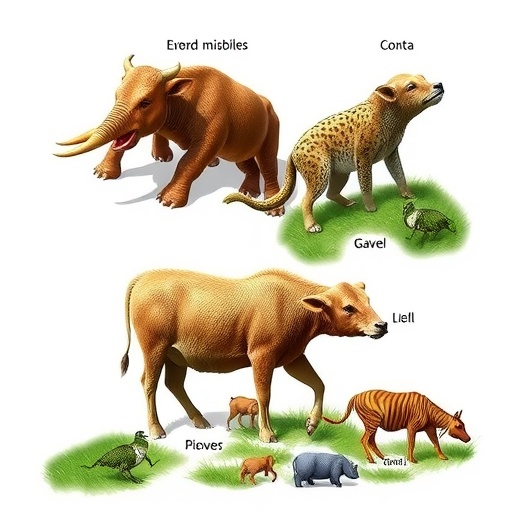A groundbreaking study published today in Nature unveils startling genetic insights into one of evolution’s most dramatic events: the transition of life from water to land. Conducted by researchers from the University of Bristol and the University of Barcelona, this investigation reveals that vastly different animal groups—from insects and worms to vertebrates—independently evolved remarkably similar genetic adaptations, underscoring predictability in evolution in response to environmental challenges. By leveraging computational genomics and comparative analyses across 154 genomes from 21 distinct animal lineages, the team identified convergent evolutionary patterns illuminating the foundational genetic toolkit required to conquer terrestrial habitats.
Historically, transitioning from aquatic to terrestrial life has been one of nature’s most complex physiological and ecological leaps. This leap required profound modifications in basic biological systems, including water retention, respiration, reproduction, and sensory functions. What makes this study revolutionary is its demonstration that these disparate lineages, separated by hundreds of millions of years, experienced parallel gains and losses of genes tied to these critical survival functions. This genetic convergence suggests that despite different evolutionary paths, similar molecular solutions arose repeatedly, dictated by the stringent demands of terrestrial environments.
The research team’s approach was exhaustive: analyzing whole genomes from a breadth of taxa spanning arthropods, mollusks, vertebrates, and various invertebrates. This comprehensive comparison allowed the dissection of common and lineage-specific genomic changes accompanying terrestrialization. Computational modeling techniques enabled the researchers to simulate evolutionary scenarios, revealing three major waves of terrestrialization over the last 487 million years. The first wave was catalyzed by arthropods, which showcase robust genetic innovation, while subsequent waves involved a spectrum of invertebrates, culminating in the emergence of fully terrestrial mollusks like land snails.
Lead author Dr. Jialin Wei emphasized the significance of their findings: “Despite originating from vastly different evolutionary branches, many terrestrial animals independently adapted the same biological functions at the genetic level. Our results highlight that traits critical for terrestrial life—such as managing water loss, metabolic shifts, and sensory perception—have evolved repeatedly but independently.” This indeed indicates a predictability encoded within the evolutionary process, driven by environmental imperatives rather than random chance alone.
A key revelation pertains to the diverse strategies for terrestrial survival observable across lineages. Smaller invertebrates maintaining partial aquatic dependencies tend to share several genetic adaptations, reflecting overlap in their semi-terrestrial lifestyles. In contrast, fully terrestrial organisms, including insects and vertebrates, exhibit more genetic divergence, pointing to unique evolutionary paths influenced by ecological niches, physiology, and stochastic events. This duality illustrates that, while convergent evolution shapes overarching adaptations, lineage-specific innovations remain critical to successful terrestrial colonization.
Co-lead investigator Dr. Marta Álvarez-Presas reflected on the evolutionary timeline unmasked by the study: “The genomic traces left by these multiple terrestrialization events provide a rare window into deep evolutionary history. This long arc from ancient arthropods to modern land snails underscores how life repeatedly reinvented itself to thrive on land.” This historical perspective offers a tantalizing glimpse at evolutionary plasticity and the predictability of certain genetic adaptations in response to environmental pressures.
The molecular mechanisms facilitating this water-to-land transition are multifaceted. Genes involved in cuticle formation, ion transport, cellular osmoregulation, and UV protection emerged as recurrent targets of evolutionary change. Additionally, metabolic adaptations supporting increased energy demands of land-based locomotion and reproduction were central to survival. Sensory genes, especially those governing mechanoreception and chemoreception, also underwent convergent evolution to accommodate novel terrestrial stimuli, underscoring the integrative complexity of adapting to life on land.
This inquiry addresses a fundamental question in evolutionary biology: is evolution a repeatable process? By detailing the independent yet parallel acquisition of genetic functions across unrelated groups, the study provides robust evidence that while genetic variation is vast, environmental constraints channel evolution along predictable pathways. This evidence challenges long-standing debates about contingency versus determinism in evolutionary trajectories, positioning terrestrial adaptation as a prime example of evolutionary convergence shaped by selection pressures.
Furthermore, the research underscores computational genomics as an indispensable tool for unraveling complex evolutionary histories. The synthetic modeling of genomic data allowed the researchers to reconstruct ancient evolutionary events with unprecedented detail, identifying both conserved and unique genetic modifications across lineages. This integration of bioinformatics, phylogenomics, and evolutionary theory marks a significant advance in understanding macroevolutionary patterns and molecular adaptation.
The implications of these findings extend beyond academic curiosity. Understanding the genetic blueprints that facilitated terrestrialization may inform conservation strategies for species vulnerable to changing habitats and climate conditions. Additionally, this knowledge enriches synthetic biology efforts aiming to engineer organisms with specific environmental resistances, potentially guiding innovations in agriculture, biotechnology, and ecological restoration.
In conclusion, this seminal research blends computational power with evolutionary insight to decode one of life’s most transformative transitions. The identification of convergent genomic signatures across vastly different organisms highlights evolution’s intricate balance between chance and necessity. As scientists continue to explore the molecular narratives written in genomes, studies like this deepen humanity’s grasp of the dynamic interplay shaping biodiversity through deep time.
Subject of Research: Animals
Article Title: Convergent genome evolution shaped the emergence of terrestrial animals
News Publication Date: 12-Nov-2025
Web References: https://www.nature.com/articles/s41586-025-09722-4
References: DOI 10.1038/s41586-025-09722-4
Image Credits: Dinghua Yang
Keywords: Evolutionary biology, History of life, Evolutionary theories, Evolutionary genetics




